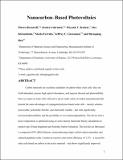Nanocarbon-Based Photovoltaics
Author(s)
Bernardi, Marco; Lohrman, Jessica; Kirkeminde, Alec; Ferralis, Nicola; Grossman, Jeffrey C.; Ren, Shenqiang; Kumar, Priyank Vijaya; ... Show more Show less
DownloadGrossman_Nanocarbon-based photovoltaics.pdf (7.039Mb)
OPEN_ACCESS_POLICY
Open Access Policy
Creative Commons Attribution-Noncommercial-Share Alike
Terms of use
Metadata
Show full item recordAbstract
Carbon materials are excellent candidates for photovoltaic solar cells: they are Earth-abundant, possess high optical absorption, and maintain superior thermal and photostability. Here we report on solar cells with active layers made solely of carbon nanomaterials that present the same advantages of conjugated polymer-based solar cells, namely, solution processable, potentially flexible, and chemically tunable, but with increased photostability and the possibility to revert photodegradation. The device active layer composition is optimized using ab initio density functional theory calculations to predict type-II band alignment and Schottky barrier formation. The best device fabricated is composed of PC[subscript 70]BM fullerene, semiconducting single-walled carbon nanotubes, and reduced graphene oxide. This active-layer composition achieves a power conversion efficiency of 1.3%—a record for solar cells based on carbon as the active material—and we calculate efficiency limits of up to 13% for the devices fabricated in this work, comparable to those predicted for polymer solar cells employing PCBM as the acceptor. There is great promise for improving carbon-based solar cells considering the novelty of this type of device, the high photostability, and the availability of a large number of carbon materials with yet untapped potential for photovoltaics. Our results indicate a new strategy for efficient carbon-based, solution-processable, thin film, photostable solar cells.
Date issued
2012-09Department
Massachusetts Institute of Technology. Department of Materials Science and Engineering; Massachusetts Institute of Technology. Research Laboratory of ElectronicsJournal
ACS Nano
Publisher
American Chemical Society (ACS)
Citation
Bernardi, Marco, Jessica Lohrman, Priyank V. Kumar, Alec Kirkeminde, Nicola Ferralis, Jeffrey C. Grossman, and Shenqiang Ren. “Nanocarbon-Based Photovoltaics.” ACS Nano 6, no. 10 (October 23, 2012): 8896-8903. © 2012 American Chemical Society
Version: Author's final manuscript
ISSN
1936-0851
1936-086X